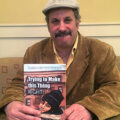ABOVE PHOTO: Grambling State University football player Naquan Smith speaks at a “State of Emergency” gathering organized by student Kimberly Monroe in Grambling, La., on Thursday, Oct. 17, 2013. Smith said the team had concerns about the football coaching staff and facilities. After two days of players skipping practice, Grambling spokesman Will Sutton announced Dustin “Dirt” Winston as the new interim football coach shortly following the student demonstration.
(AP Photo/The News-Star, Dacia Idom)
If we learned anything from Grambling University Football’s problems, it’s that it’s hard out here for Historically Black Colleges and Universities…and even harder for their students.
By Chris Murray
For the Chris Murray Report and the Philadelphia Sunday Sun
As a graduate of Morgan State University, an Historically Black University in my native Baltimore, I found myself watching intently as the saga at Grambling State University played itself out.
The school’s football team decided to boycott their scheduled game with Jackson State University to protest the horrid conditions under which they were expected to play and practice.
Among those conditions were mold and mildew in the weight and the locker rooms, uniforms cleaned so poorly that some players had to fight staph infections, long bus trips poorly cleaned uniforms which caused some players to have staph infections, and having to take trips to places like Indiana and Mississippi by bus while administrators got plane tickets for themselves.
The players were also upset about the firing of head coach, and Grambling University icon, Doug Williams, who raised funds to renovate the athletic facilities that the university, inexplicably, turned down. The team returned to practice because Williams, who talked to a local businessman who has pledged assistance to the football team, asked them to.
But that wasn’t the only thing I kept my eye on. As a journalist, I kept my eye on how this was being covered in the school’s media. Two editors from the school’s newspaper The Gramblinite, Kimberly Monroe and David Lankster Sr. were sanctioned by the university for posting photos illustrating the poor conditions that the football team was protesting on Twitter and for being perceived as taking part in the protests. The Gramblingite was also criticized for using anonymous sources to report the story.
(That last critique was leveled by a former president of the National Association of Black Journalists, but I’ll get into that later. )
If you looked up the phrase “glaring lack of leadership” in the dictionary and didn’t see the situation at Grambling as part of the definition, I’d have to ask you to get another dictionary. Between the infighting, and the bad behavior on the part of the adults who are charged with looking out for the welfare of the football team and The Gramblingite staff, this was a red-hot mess.
Let’s start with the athletic facilities themselves. Because of cuts to the athletic program, former Head Coach Williams reached out to fellow Grambling athletes including James “Shack” Harris to ask for money to make the necessary repairs to the weight room floor. But because he didn’t go through what the University perceived as the “proper channels”, the university didn’t take the money.
Now Grambling President Frank Pogue and Athletic Director Aaron James, the folks that were taking the plane to those far away games that the actual players had to go to on the bus, decided that instead of working with Williams and his alumni partners to find a solution, they’d fire Williams instead.
Without explaining it to the players.
Something that made this group of students, a group that was already kind of close to its boiling point with Grambling administration because 1,700-mile bus rides will make anyone cranky, even more so.
So they refused to get on the bus to go to Jackson State last Friday. And gave ESPN’s Pedro Gomez a letter explaining why. The University finally listened…but not until everyone from Bill Rhoden of The New York Times to Roland Martin of TVOne began seating Grambling students in their interview chairs.
Meanwhile, the students at The Gramblinite did what any school’s student-run newspaper should do when in the center of a story like this…they reported the story.
Like any media outlet these days, The Gramblingite used social media platforms like Twitter and Instagram to tell the story in real time. The paper posted photos of the conditions on Twitter to confirm what they got from the anonymous sources that spoke to them…which is what you’re supposed to do.
But Grambling’s Director of Communications Will Sutton chastised the students publicly for something that he wouldn’t have raised an eyebrow about during his days as a reporter. Sutton, a past president of NABJ who worked for the Philadelphia Inquirer and the News and Observer in Raleigh, N.C. before coming to Grambling, used Twitter to reprimand the students for posting the photos and using unnamed sources.
“@thegramblinite Are you serious? “Unidentified”? Really? Step up and be identified and stop hiding, or don’t use them as sources.”
Now most people who put themselves out there as anonymous sources do so because being public could lead to repercussions. Isn’t the reason you protect unnamed sources to make sure there is no retaliation, i.e. a person gets fired or gets kicked out of school?
The fact that the student journalists were called on the carpet was more about not wanting Grambling’s dirty laundry on the front lawn than it was about the violation of university rules.
And besides, it’s illegal, said Frank LoMonte, the executive director of the Student Press Law Center.
“Public university employees can’t use their governmental authority to punish journalists for their editorial content, period,” LoMonte told the Maynard Center for Journalism Education in an interview.
While Grambling officials can point to drastic budget cuts by Louisiana’s Republican Gov. Bobby Jindal as a factor because they’ve forced the school to do more with less and a lack of alumni giving for the problems with the football team, the bottom line is that this walkout happened due to a lack of respect, not a lack of financing.
The adults in any situation are supposed to know better.
Too bad that in this case, very few did.
















Leave a Comment